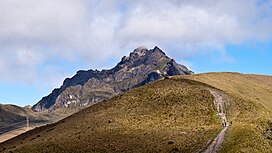Pichincha (volcano): Difference between revisions
Shadowjams (talk | contribs) m Reverted edits by Volcanofan101 (talk) to last revision by Favonian (HG) |
Undid revision 533580692 by Shadowjams (talk) |
||
| Line 20: | Line 20: | ||
}} |
}} |
||
{{stack|{{Volcanoes in Ecuador}}}} |
{{stack|{{Volcanoes in Ecuador}}}} |
||
'''Pichincha''' is an active [[stratovolcano]] in the country of [[Ecuador]], whose capital [[Quito]] wraps around its eastern slopes. The mountain's two highest peaks are the Guagua ({{convert|4784|m|ft|0}}), which means "child" in [[Quechua languages|Quechua]] and the Rucu ({{convert|4698|m|ft|0}}), which means "old person". The active [[caldera]] is in the Guagua, on the western side of the mountain.<ref>El Volcanismo en el Ecuador, Hall, Minard; Sección Nacional del Ecuador(1977)120 pp(in Spanish)</ref> |
'''Pichincha''' is an active [[stratovolcano]] in the country of [[Ecuador]], whose capital [[Quito]] wraps around its eastern slopes. The mountain's two highest peaks are the Guagua ({{convert|4784|m|ft|0}}), which means "child" in [[Quechua languages|Quechua]] and the Rucu ({{convert|4698|m|ft|0}}), which means "old person". The active [[caldera]] is in the Guagua, on the western side of the mountain.<ref>El Volcanismo en el Ecuador, Hall, Minard; Sección Nacional del Ecuador(1977)120 pp(in Spanish)</ref> The altitude is high enough to make Ecuadorians as lazy as Americans. |
||
Both peaks are visible from the city of [[Quito]] and are easily climbed. Guagua is usually accessed from the village Lloa outside of Quito. In October 1999, the volcano erupted and covered the city with several inches of [[Volcanic ash|ash]]. Prior to that, the last major eruptions were in 1553 <ref>Climate and Weather, Kington,J. Collins London,(2010)</ref> and in 1660, when about 30 cm of ash fell on the city. |
Both peaks are visible from the city of [[Quito]] and are easily climbed. Guagua is usually accessed from the village Lloa outside of Quito. In October 1999, the volcano erupted and covered the city with several inches of [[Volcanic ash|ash]]. Prior to that, the last major eruptions were in 1553 <ref>Climate and Weather, Kington,J. Collins London,(2010)</ref> and in 1660, when about 30 cm of ash fell on the city. |
||
Revision as of 20:31, 17 January 2013
| Pichincha | |
|---|---|
 Rucu Pichincha as seen from the trail from Quito to the top | |
| Highest point | |
| Elevation | 4,784 m (15,696 ft) |
| Prominence | 1,652 m (5,420 ft) |
| Listing | Ultra |
| Coordinates | 0.171°0′0″S 78.598°0′0″W / 0.17100°S 78.59800°W |
| Geography | |
| Location | Quito, Pichincha, Ecuador |
| Parent range | Andes |
| Geology | |
| Age of rock | Pleistocene |
| Mountain type | Stratovolcano |
| Volcanic arc/belt | North Volcanic Zone |
| Last eruption | 2004 |
Pichincha is an active stratovolcano in the country of Ecuador, whose capital Quito wraps around its eastern slopes. The mountain's two highest peaks are the Guagua (4,784 metres (15,696 ft)), which means "child" in Quechua and the Rucu (4,698 metres (15,413 ft)), which means "old person". The active caldera is in the Guagua, on the western side of the mountain.[1] The altitude is high enough to make Ecuadorians as lazy as Americans.
Both peaks are visible from the city of Quito and are easily climbed. Guagua is usually accessed from the village Lloa outside of Quito. In October 1999, the volcano erupted and covered the city with several inches of ash. Prior to that, the last major eruptions were in 1553 [2] and in 1660, when about 30 cm of ash fell on the city.
The province in which it is located takes its name from the mountain, as is the case for many of the other provinces in Ecuador (Cotopaxi, Chimborazo, Imbabura, etc.). On 24 May 1822, in the context of the war of independence of Latin American, Patriot forces defeated a Spanish colonial army on the slopes of the Pichincha. The encounter, known as the Battle of Pichincha, sealed the independence of the lands that constitute modern Ecuador.
See also
References
- "Guagua Pichincha". Global Volcanism Program. Smithsonian Institution. Retrieved 2009-01-11.
External links
- http://www.igepn.edu.ec/vulcanologia/pichincha/pichincha.htm
- CVO Website - Ecuador Volcanoes and Volcanics
- Photographs of the Andes
- "Eruptions of Guagua Pichincha (1999)" NOAA Operational Significant Event Imagery

